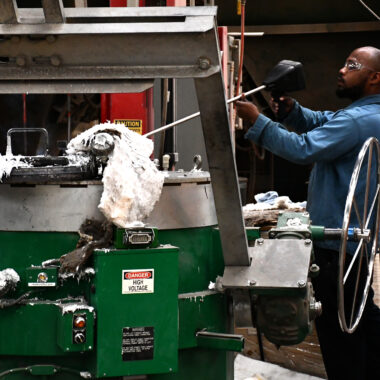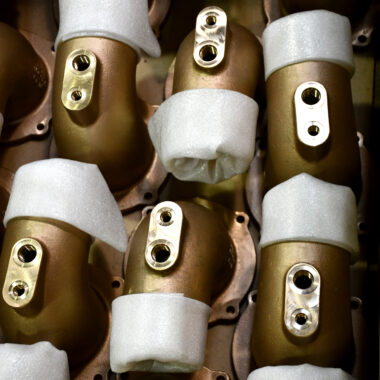Grasping About Aluminum Casting: Methods Demystified
Grasping About Aluminum Casting: Methods Demystified
Blog Article
Explore the World of Aluminum Casting: Expert Strategies and keys
In the world of production, light weight aluminum casting stands as a critical procedure, vital for the creation of a large variety of items. Behind the seemingly uncomplicated strategy exist a plethora of complex aspects, frequently unbeknownst to many. As we navigate via the world of aluminum casting, there exists a realm of expert secrets and techniques that can elevate the high quality of the end products and enhance the manufacturing process. By revealing these concealed gems and discovering the nuances of this craft, a whole brand-new measurement of possibilities arises, guaranteeing to transform the way we involve and regard with aluminum spreading.

The Fundamentals of Light Weight Aluminum Spreading
Aluminum casting, an essential process in production, entails the pouring of liquified aluminum into a mold and mildew to attain preferred structures and forms. This functional technique is extensively utilized throughout numerous industries due to light weight aluminum's phenomenal properties such as high strength-to-weight proportion, corrosion resistance, and thermal conductivity.
The procedure begins with the melting of light weight aluminum in a heater at temperature levels surpassing 1220 ° F(660 ° C ) Once the light weight aluminum reaches its liquid state, it is put into a pre-designed mold and mildew tooth cavity. The mold, generally made from products like steel or sand, determines the final form of the cast light weight aluminum part.
After pouring, the light weight aluminum is delegated cool and solidify within the mold - about aluminum casting. This cooling duration is important as it determines the integrity and top quality of the final item. Once solidified, the mold is gotten rid of, disclosing the recently developed light weight aluminum casting
Expert Tips for Effective Casting
To accomplish ideal outcomes in aluminum spreading, meticulous focus to detail during the mold style phase is critical for guaranteeing effective end results. Surveillance and controlling the metal temperature throughout the spreading procedure can aid prevent concerns such as premature solidification or porosity in the final item.
A well-prepared mold and mildew surface can add to much better steel circulation, lowered disturbance, and boosted surface area finish on the actors part. By paying close focus to these insider ideas, producers can boost the quality and performance of their aluminum casting processes.
Advanced Strategies in Light Weight Aluminum Casting
Making use of cutting-edge methods and sophisticated methods, the realm of aluminum casting has seen a considerable evolution in the direction of advanced techniques that push the borders of conventional practices. One such method is vacuum casting, which involves creating a vacuum cleaner environment to eliminate air from the mold and mildew dental caries, leading to better and more complex castings with reduced porosity. In addition, financial investment casting, also understood as lost-wax spreading, is a polished technique that enables complicated forms and slim wall surfaces, resulting in detailed and exact aluminum components.

Moreover, progressed simulation software plays a critical role in maximizing spreading styles and forecasting possible issues, permitting adjustments to be made prior to the real casting process starts. By embracing these innovative methods, makers can boost their light weight aluminum casting capacities to new heights, meeting the needs of modern sectors with accuracy and advancement.
Understanding Different Casting Methods
Various casting techniques use one-of-a-kind advantages and are picked based on variables such as the complexity of the design, manufacturing quantity, product needs, and cost considerations. One of the most common casting methods is sand casting, where a mold like it and mildew is developed using sand as the key material.
An additional preferred casting approach is die casting, which involves infusing liquified metal into a mold and mildew dental caries under high pressure. By recognizing the nuances of various casting approaches, suppliers can make informed choices to maximize their production processes and attain the preferred outcomes.
Making The Most Of Efficiency in Casting Operations
With a strong grasp of the nuances of different spreading approaches, producers can streamline their operations to improve performance in steel construction procedures. Making best use of efficiency in casting procedures requires a systematic approach that concentrates on optimizing every action of the casting procedure. One key technique is to implement lean manufacturing principles to eliminate waste and boost overall efficiency. By determining and removing traffic jams in the assembly line, manufacturers can enhance process and reduce lead times.
Moreover, spending in innovative modern technology and equipment can substantially improve effectiveness in casting operations. Automated systems, robotics, and computer-aided layout (CAD) software application can streamline processes, reduce errors, and rise output. Furthermore, training staff members on the most recent strategies and best methods can likewise add to making the most of effectiveness in casting procedures.
Routine maintenance of tools and devices is vital to reduce and avoid break downs downtime - about aluminum casting. Carrying out a proactive upkeep routine can assist determine potential issues prior to they rise, guaranteeing smooth operations and uninterrupted production. Overall, by anchor focusing on efficiency and continuous improvement, producers can enhance their casting procedures and stay affordable in the industry

Conclusion
In verdict, the globe of light weight aluminum spreading supplies a vast range of opportunities for those looking to create sturdy and detailed metal things. Recognizing the various spreading methods and enhancing efficiency in operations are key elements to achieving top quality results in aluminum casting.
One such technique is vacuum spreading, which entails developing a vacuum cleaner environment to eliminate air from the mold and mildew cavity, leading to greater quality and more complex spreadings with lowered porosity (about aluminum casting). Furthermore, financial investment casting, likewise known as lost-wax casting, is a refined method that enables for complicated forms and thin wall surfaces, resulting in precise and thorough light weight aluminum parts
One of the most typical spreading methods is sand spreading, where a mold is developed making use of sand as the main product.An additional preferred casting method is pass away spreading, which involves infusing molten steel into a mold and mildew tooth cavity under high pressure. Recognizing the numerous casting approaches and enhancing performance in operations are crucial components to achieving top notch results in light weight aluminum spreading.
Report this page